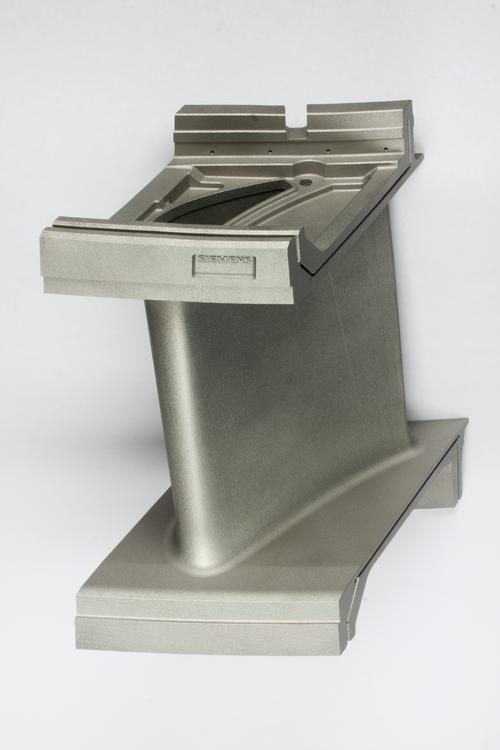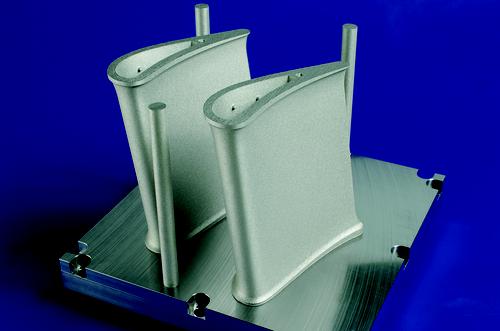Gas Turbine Blades Made Faster With Metals 3D Printing
Siemens and Fraunhofer Institute for Laser Technology have achieved a faster production process based on selective laser melting for speeding up the prototyping of big, complex metal parts in gas turbine engines.
July 26, 2016
Lately, much of the news about 3D printing metals is aimed at improving end production: bigger parts, made faster, from new materials. But what about speeding up the prototyping process of large precision metal parts, like gas turbine engine blades and vanes? That's what Germany's Siemens and Fraunhofer Institute for Laser Technology (ILT) have achieved: a faster production process based on selective laser melting (SLM).
The hot path components of gas turbines, like the blades and vanes, are conventionally made of superalloys with a precision casting process. Parts must be tested in real-life situations using gaseous or liquid fuels at very high heat, so prototyping can get very expensive during the multiple iterations that are needed. Each loop of that iterative process can take several months.

Mounted on the turbine engine housing, guide vanes channel hot gas to the movable rotor blades. They consist of an airfoil with the cooling structure and two platforms. These were made of Inconel 718 with a specialized selective laser sintering process that speeds up, and lowers the cost of, prototyping compared to the long iterative cycles required when they are made with casting.
(Source: Fraunhofer Institute for Laser Technology)
This length of time and high expense has reduced the number of tests for these components that it's possible to complete. But the goal is to optimize the turbine engine's combustion process to make them more efficient. Siemens' Clean Energy Center, a new combustion test center that opened last year near Berlin, is tasked with testing the parts to help develop and refine gas turbine design.
READ MORE ARTICLES ON 3D PRINTING:
Fraunhofer ILT says that its own engineers and scientists, plus those from Siemens' new test center, have developed a more modular way of fabricating turbine vanes for the engine's hot gas area by designing a new process chain that depends on additive manufacturing (AM). Much of the new designs that optimize combustion depends on complex internal cooling structures for the vanes. These guide vanes, mounted on the turbine housing, channel the hot gas to the movable rotor blades. They consist of an airfoil with the cooling structure and two platforms. The parts measure up to 250 mm (9.8 in).

These segments of turbine engine guide vanes are individually manufactured with a specialized selective laser sintering process, then brazed together. This removes the need for internal supports, makes it easier to improve surface quality, and speeds up the feedback process during prototyping.
(Source: Fraunhofer Institute for Laser Technology)
Using SLM, the researchers developed a specialized process for manufacturing the parts with high dimensional accuracy, as well as superior surface quality. But that wasn't enough: even fabricating them in one piece with AM required adding internal supports to the blade. Instead of casting them, or 3D printing them, in a single piece, the airfoil and the platforms are made separately and then brazed together.
Not only does this remove the need for supports, it makes it easier to improve surface quality, and speeds up the feedback process. The approach may also be applied to other components. These could be made either using SLM-produced modules brazed together, or by brazing SLM-made and cast modules together. In that case, cast modules could be the simpler parts and the SLM-made ones could be the more complex or variable designs.
 3D Printing's Brave New World. Ann Thryft will lead a panel discussion on one of the hottest topics in manufacturing: 3D printing. Come hear "3D Printing: The Brave New World of Manufacturing" at the Embedded Systems Conference, Sept. 21-22, 2016 in Minneapolis. Register here for the event, hosted by Design News’ parent company UBM.
3D Printing's Brave New World. Ann Thryft will lead a panel discussion on one of the hottest topics in manufacturing: 3D printing. Come hear "3D Printing: The Brave New World of Manufacturing" at the Embedded Systems Conference, Sept. 21-22, 2016 in Minneapolis. Register here for the event, hosted by Design News’ parent company UBM.
Ann R. Thryft is senior technology editor, materials & assembly, for Design News. She's been writing about manufacturing- and electronics-related technologies for 28 years, covering manufacturing materials & processes, alternative energy, machine vision, and all kinds of communications.
About the Author(s)
You May Also Like
.jpg?width=300&auto=webp&quality=80&disable=upscale)


